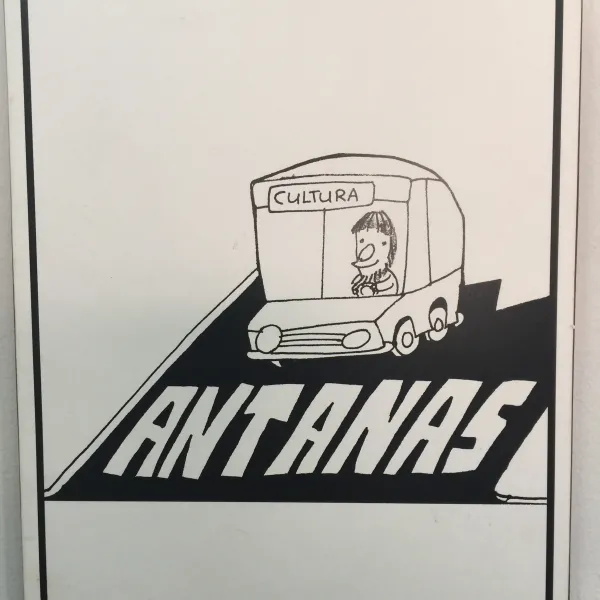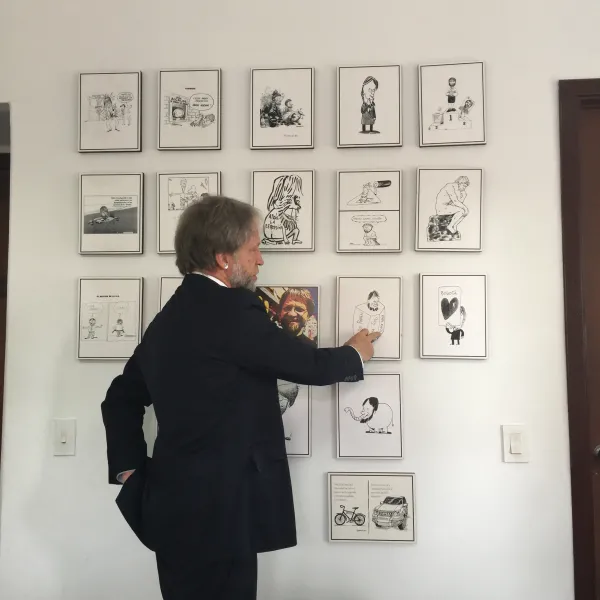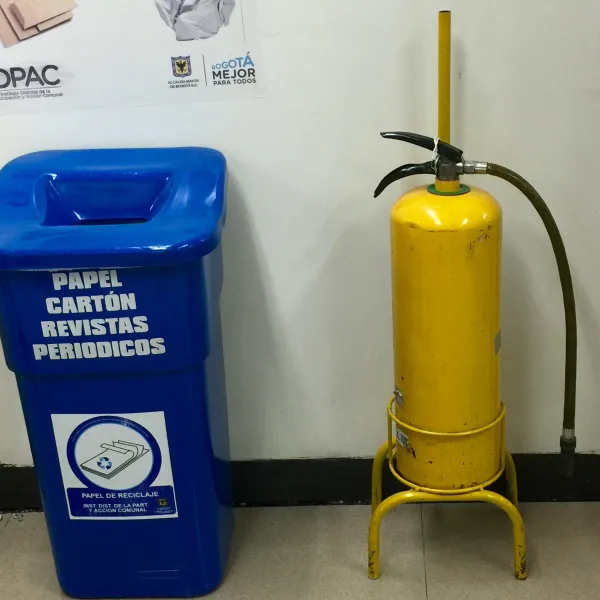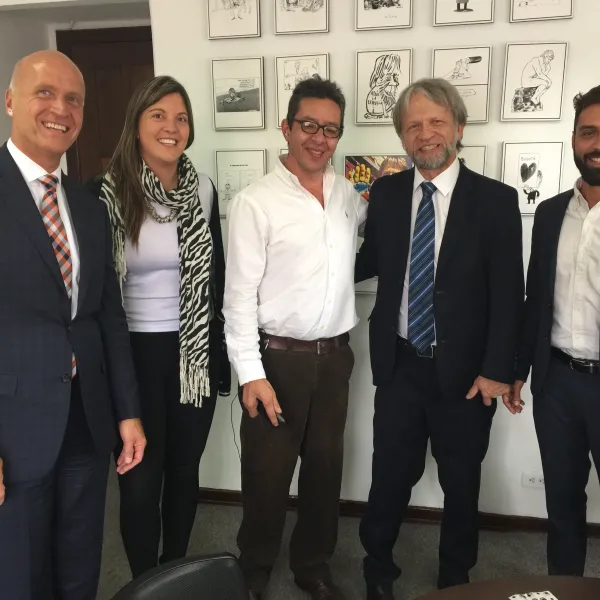Citizenship Culture


Bogotá, Colombia
The Action
Against civic apathy and a rough history of violent conflict, former Bogotá mayor Antanas Mockus put up humor, surprise, art, and gender consciousness. During his administration, and through his subsequent work with nonprofit Corpovisionarios, Mockus has sought to disrupt both people’s expectations and socially constructed norms of the role of government and the obligations of citizenship, inspiring Bogotános to voluntarily take personal responsibility for the cultural and civic character of the city.
Democracy Challenge
Democracy requires not only institutions and laws but also social and moral norms governing behavior: a pro-social civic culture. Dense urban spaces sometimes foster that culture, but sometimes they undermine it, with people feeling too isolated or exhausted to contribute. In Colombia, a long period of intense violent conflict kept urban residents out of civic spaces, making it difficult to create and maintain a shared civic identity and sense of belonging. For women, as elsewhere, this alienation has been compounded by gender discrimination including gender-based violence.
How It Works & How They Did It
Antanas Mockus served two nonconsecutive terms as Bogotá’s mayor (1995 to1997 and 2001 to 2003). He was a complete political novice when he first decided to run; moreover, he was best known for mooning a group of rowdy students while serving as the head administrator of Colombia’s prestigious National University (the incident led to his removal). But voters in Bogotá were tired of the status quo. The city was viewed as dysfunctional. There was corruption, and a monumental waste management crisis. The violence was unceasing, with a murder rate that made Bogotá one of the world’s most dangerous cities.
Here is what I learned: people respond to humor and playfulness from politicians. It is the most powerful tool for change we have.
Mockus set out to transform the culture both inside and outside of government—to build a “citizenship culture” that would support rule of law by encouraging Bogotános to self-regulate (via moral norms) and to regulate each other (via social norms). His idiosyncratic approach reflects his unique background, combining insights from behavioral economics, social psychology, sharp marketing instincts and personal charisma—all in the service of whipping residents and their government into shape. The theory of change posits that public behavior is an expression of the expectations we have for ourselves and for others. Therefore, changing those expectations can create and support a “citizenship culture” in which people voluntarily do pro-social things. Exhibiting cultural leadership, according to the movement that Mockus started, should remain the nucleus of public work.
From a practical policy standpoint, the two tent poles have been:
(1) Government as moral educator: political performance art
This became Mockus’ signature—using the bully pulpit to grab attention, surprise Bogotános and disrupt expectations around the form, tone, and content of government messaging and policy. Long before there were memes or viral videos, Mockus hired mimes to mock bad drivers. He released a video of himself showering to promote a program of voluntary water conservation. He introduced hugs into conflict negotiations and he routinely asked men to wear large earring-shaped stickers during meetings to disarm masculine posturing. Mockus calls such campaigns “cultural acupuncture” because they apply pressure at critical points where behavior is susceptible to change. He traced this approach to his university days.
I was able to defend against the pressure from violent groups with a simple idea: ‘Let us transform the small—our family; our classrooms; the way we raise our children; the division of household labor, the machismo, and the jealousy.’ … Everyone wanted change and in those years, I learned to pursue small changes first.
As mayor, Mockus’ performance art often continued to address and disrupt a pervasive culture of violence. In one instance, he organized a public clinic to “vaccinate” people against domestic violence. People would wait in line and when it was their turn for the “shot” a psychologist would ask, “when in your life has anyone hurt you?”
“The first Monday, we had more than 15,000 participants and one month later, there were 30,000,” Mockus said. “Of course there was criticism. It was hard for people to open up, but the exercise was almost therapeutic.”
Mockus said that as mayor, residents trusted him and accepted his unorthodox exercises, sometimes without fully understanding the goal.
“I think people also liked playfulness,” Mockus said. “There were moments of strong emotion from the people and from myself.”
(2) Old fashioned accountability: taking pride in service
Mockus also recognized that Bogotá’s bureaucratic culture was infected with corruption, patronage, and inertia. To begin changing cultural expectations and behavior within government, his administration used psychology and “small changes” but also implemented more traditional process change. The playbook included:
- Empowering and connecting civil servants to instill a sense of pride and camaraderie. “I used to organize large staff meetings with the theme: one public servant, one mayor,” Mockus said. “My message was clear: what I can do is very little in comparison to what you can achieve by improving your customer service.” He instituted a “fair of the admirable,” in which agencies showcased their most successful work. And he created cross-agency groups to educate civil servants about what other departments were doing. “We discovered that people who were part of institutions had a very good sense of how their institutions functioned,” Mockus said. “They had an informed opinion. However, when water agency employees had to give an opinion on the telecommunications agency, they had similar biases to those found in the resident survey. There was complete ignorance of what the other [agency] was doing… At the beginning of the process, I noticed something about the language: during the interagency council, when people said “we/us” they were not speaking about the people at the table, they usually referred to their own agency. I used to say: ‘Let us not say ‘us’ when you are really saying ‘some of us,’ let us not invade each other's space by using ‘us’.’”
- Setting the right tone at the top. “My private secretary and later, the transit secretary, had worked as prosecutors in the past,” Mockus said. “When I was choosing people to take on mobility and transit, my selection criteria was clear: anticorruption. My transit secretary did not know anything about transportation, but he knew about corruption and regulations.”
- Digging deep into processes to improve customer service and public trust. “There was a system of recommendation that took me a while to figure out,” Mockus said. “From time to time, a letter from a councilmember would come to my office, asking us to speed up the pension payment process for certain citizens. We studied how long it would take to complete the payment process in normal conditions. We found that the process for regular people would take around nine months, but for the referred individuals, [they] would have their pensions in only five days. As a result, we decided to shorten the process to fifteen days for everyone.”
Some initiatives deployed both strategies, like his efforts to tame Bogotá’s chaotic and dangerous traffic. Mockus hired mimes to shame bad drivers and distributed “citizens’ cards” with large thumbs up and thumbs down images, for flashing at courteous and rude drivers, respectively. But his administration also dissolved the old transit police force (which had a reputation for corruption) and worked with the national police service to replace them.




How’s It Going?
- Sustainable results. Mockus told the New York Times in 2015 that the traffic initiative reduced fatalities by more than half over a decade. He also pointed to a campaign around voluntary water conservation—his response to a critical water shortage—which changed behavior such that Bogotá still has historically low consumption levels even after extending service to new neighborhoods.
- Memorable power of art. Mockus’ art has had staying power in the minds of Bogotános—and this is perhaps a more difficult feat than the mechanics of policy change. In interviews with NDI and Living Cities, city officials and citizens remember the Mockus years as an inflection point that changed their thinking about government and the duties of citizens.
- Continuing the work. In 2007, Antanas Mockus founded an independent nonprofit, Corpovisionarios, to promote citizenship culture (cultura ciudadana). The organization conducts research, provides advisory services, and implements domestic and international projects that “facilitate positive voluntary changes in collective behaviors” using tools pioneered by Mockus during his tenure as mayor. A signature project is the citizenship culture survey, which has been conducted in dozens of cities in Colombia and internationally, allowing for comparisons of civic and social attitudes and expectations across contexts.
Considerations
- Method in madness. Silliness and provocation are risky for anyone, and much more so for public leaders charged with tackling very serious problems. Mockus’ innovation lay in using the former in service of the latter. Crucially, his “cultural acupuncture” campaigns never minimized or made light of the alienation and tragedy afflicting Colombians. Quite the opposite—Mockus got people’s attention, and then used that opening to make a point or to spark new dialogue—about sensitive and serious issues. Ever the academic, he could (and can) call upon psychological, sociological, and philosophical concepts to give weight and meaning to his “stunts” and frame them in deeply humanist terms.
- Authenticity. Given today’s fragmented media landscape, it is harder than ever to get and keep the public’s attention. But authenticity remains the key to creative content that lands with impact. Mockus’ genuine quirkiness and intellectualism attracted voters to him, and his ability to retain and build on that brand while in office—treating the entire city as his classroom—were yet another factor in drawing a distinction between publicity stunts and cultural acupuncture.
- Sustainability through depersonalization. As Mockus himself notes, his city-changing art was successful because citizens trusted him; he had a personal relationship with residents, and they were willing to follow where he would lead. The challenge for the nonprofit that he created, Corpovisionarios, is to create methodologies, institutions, and programs that can embody Mockus’ outlook—including both his passion for public service and citizenship and his “cultural acupuncture” methods—without depending on his personal charisma and reputation for legitimacy.
Point of Contact
Henry Murrain
CEO
Corpovisionarios
[email protected]
Who Else Is Trying This?
- Barcelona, Spain: In 2015, voters in eight Spanish cities elected a wave of populist, antiestablishment figures from new parties promising a new kind of politics. Among them was Ada Colau, Barcelona’s first female mayor. Colau had risen to prominence in 2013 as a fair housing activist testifying before parliament—she called a banking industry representative a “criminal” and then refused to retract the statement. The clip went viral. But perhaps more representative of her persona is a humble, populist, everyman appeal which is, paradoxically, combined with intense personal charisma. During that famous 2013 testimony she demurred a leadership role and called herself “a momentarily visible face of a citizens’ movement,” a theme she has kept while in office. She has also spoken of wanting to “feminize” politics, which means excising macho, confrontational rhetoric and being unafraid to show emotion in public. Read more
- New York City, US: The New York City Department of Health and Transportation partnered with non-profits KaBOOM!, ArtBridge, and DreamYard to encourage exercise and play through art. Together they commissioned two bright murals to color outdoor staircases in the South Bronx, home to obesity rates as high as 35 percent. The murals were designed with resident input and feature birds that invoke the neighborhood’s ecology and culture. Read more
Additional Reading
The Art of Changing a City
Social norms and traffic behavior: Citizenship Culture as Public Policy in Bogotá, Colombia
Cultural Agents Reloaded: The Legacy of Antanas Mockus
Cultura Ciudadana como Política Pública: Entre Indicadores y Arte
Antípodas de la violencia : Desafíos de cultura ciudadana para la crisis de (in)seguridad en América Latina
This action was originally developed for Big Bold Cities, an initiative of Living Cities and the National Democratic Institute (NDI); republished here with the permission of Living Cities.